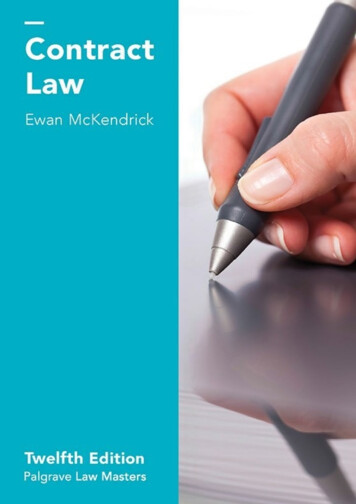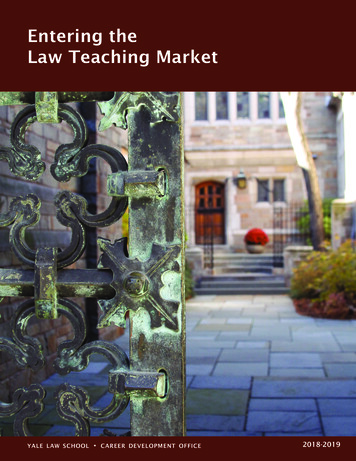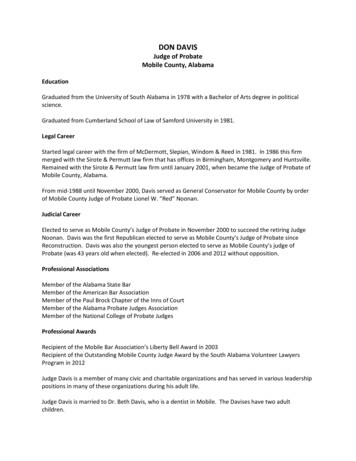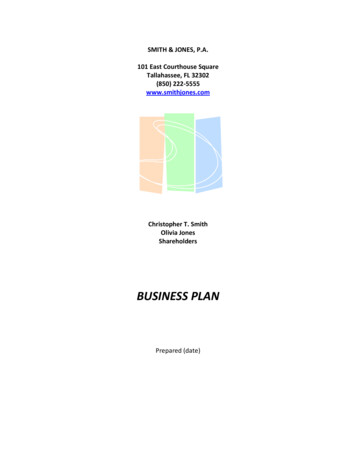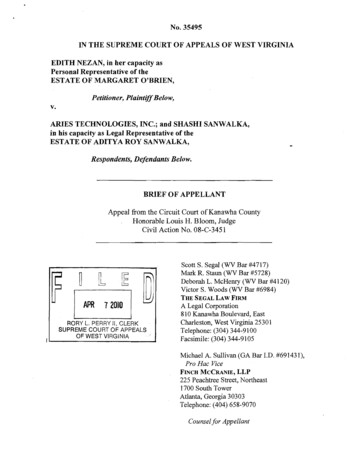
Transcription
No. 35495IN THE SUPREME COURT OF APPEALS OF WEST VIRGINIAEDITH NEZAN, in her capacity asPersonal Representative of theESTATE OF MARGARET O'BRIEN,Petitioner, Plaintiff Below,v.ARIES TECHNOLOGIES, INC.; and SHASHI SANWALKA,in his capacity as Legal Representative of theESTATE OF ADITYA ROY SANWALKA,Respondents, Defendants Below.BRIEF OF APPELLANTAppeal from the Circuit Court of Kanawha CountyHonorable Louis H. Bloom, JudgeCivil Action No. 08-C-34S1Scott S. Segal (WV Bar #4717)Mark R. Staun (WV Bar #5728)Deborah L. McHenry (WV Bar #4120)Victor S. Woods (WV Bar #6984)THE SEGAL LAW FIRMAPR72010RORY L. PERRY II, CLERKSUPREME COURT OF APPEALSOF WEST VIRGINIAA Legal Corporation810 Kanawha Boulevard, EastCharleston, West Virginia 25301Telephone: (304) 344-9100Facsimile: (304) 344-9105MichaelA. Sullivan (GA Bar I.D. #691431),Pro Hac ViceFINCH MCCRANIE, LLP225 Peachtree Street, Northeast1700 South TowerAtlanta, Georgia 30303Telephone: (404) 658-9070Counsel for Appellant
TABLE OF CONTENTSI.BACKGROUND . 2II.ASSIGNMENTS OF ERROR . 9III.STANDARD OF REVIEW . 9IV.ARGUMENT . 10A.THE CIRCUIT COURT ERRED BY DISMISSING PLAINTIFF'SCOMPLAINT ON THE BASIS OF LACK OF PERSONAL mRISDICTION. 111.2.B.V.The Circuit Court Erred by Dismissing the Defendants on the BasisThat a Personal Representative ofthe Estate of a NonresidentIs Not Amendable to Service of Process under the West VirginiaLong-Arm Statute . 13a.The Circuit Court Erred as a Matter of Law by ConcludingThat the Personal Representative of an Estate Of aNonresident Is Not Amendable to Service of Processunder the West Virginia Long-Arm Statute . 13b.Assuming Arguendo That a Representative of aNon-Resident's Estate Is Not Subject to Service ofProcess under the Long-Arm Statute, Such Ruling DoesNot Justify Dismissal of the Employer of theRepresentative's Decedent . 20The Circuit Court Erred.by Dismissing Plaintiffs Complaint on theAlternative Basis That the Defendants' Contacts with WestVirginia Failed to Satisfy Due Process, Where Plaintiff Has NotOnly Alleged, but Has Presented Proofby Way of Expert Testimony,That All of the Pilot's Negligent Acts And/or Failures to ActProximately Causing the Accident Occurred in West Virginia . 23THE CIRCUIT COURT ABUSED ITS DISCRETION BY DISMISSINGPLAINTIFF'S COMPLAINT FOR FORUM NON CONVENIENS UNDERWEST VIRGINIA CODE § 56-1-1A, WH ERE PLA1NTIFF'S CAUSE OFACTION AROSE IN WEST VIRGINIA AND WH ERE THE FACTORSFOR DISMISSAL UNDER THE STATUTE DO NOT MILITATE INFAVOR OF DISMISSAL . 26CONCLUSION . : . ·36
TABLE OF AUTHORITIESCASESPAGES:Abbott v. Owens-Corning Fiberglass Corp., 191 W. Va. 198,444 S.E.2d 285 (1994) . 12ALS Scan, inc. v. Digital Servo Consultants, inc., 293 F.3d 707 (4 th Cir. 2000) . 24Bailey v. Federal intermediate Credit Bank, 788 F.2d 498 (8th Cir.), cert. denied,479 U.S. 915 (1986) . 18Beynon v. Montgomery Cablevision Limited Partnership, 351 Md. 460,718 A.2d 1161 (1998) . :- . 30Blimka v. My Web Wholesaler, LLC, 143 Idaho 723, 152 P.3d 594 (2007) . 14Butterfield (Litigation Guardian oj) v. Butterfield Estate, et al., 96 O.A.C. 262, 23 M.V.R.3d 192 . 33Cannelton industries, inc. v. Aetna Cas. & Sur. Co. ofAmerica, 194 W. Va. 186,460S.E.2d 1 (1994) . 10Carefirst ofAlaryland v. Carefirst Pregnancy Centers, inc., 334 F.3d. 390(4th Cir. 2003) . 23, 24Christian Science Bd. of Dir's. of the First Church of Christ v. Nolan, 259 F.3d 209(4th Cir. 2001) . 24Chrystal R.M v. Charlie A.L., 194 W. Va. 138,459 S.E.2d 415 (1995) . 10Clarkv. Milam, 830 F.Supp. 316 (S.D. W.Va.l993) . 14Columbia Briargate Co. v. First National Bank in Dallas, 713 F.2d 1052(4 th Cir.1983) . 24Columbia Hospital Ass 'no v. City of Milwaukee, 35 Wis.2d 660, 151 N.W.2d 750 (1967) . 18Director, Office of Workers , Compensation Programs V. Bethlehem Mines Corp., 669 F.2d187(4thCir.1982) . 17Easterling V. American Optical Corp., 207 W. Va. 123, 529 S.E.2d 588 (2000) . 10, 12
Famous Players Development Corp. v. Central Capital Corp., 6 O.R. 3d 765, c.P.c. (3d)286,53 O.A.C. 185 (Div. Ct. 1991) . 33Fruehauf Corp. v. Huntington Moving & Storage Co., 159 W. Va 14,217 S.E.2d 907(1975) . 19Gentryv. Mangum, 195 W. Va. 512,466 S.E.2d 171 (1995) . 35Guyan Motors v. Williams, 133 W. Va. 630, 635, 57 S.E.2d 529, 532 (1950) . 28,29Guyton v. Pronav Ship Management, Inc., l39 F.Supp.2d 815 (S.D.Tex. 2001) . 22Hanson v. Denckla, 357 U.S. 235 (1958) . 24""Harless v. First Nat. Bank in Fairmont, 169 W. Va. 673,289 S.E.2d 692 (1982) . 21Harman v. Pauley, 522 F.Supp. 1130 (S.D. W.Va. 1981) . 14Helicopteros Nacionales DeColombia, S.A. v. Hall, 466 U.S. 408 (1984) '" . 23, 24Heston Corp., 254 Kan. 941, 870 P.2d 17 (1994) . '" . 15Hodge v. Sans Mfg. Co., 151 W. Va. 133, 150 S.E.2d 793 (1966) . 23Illinois Dep't of Public Aid v. Schweiker, 707 F.2d 273 (7th Cir .1983) . 17In re Oil Spill by Amoco Cordiz off Coast of France, 491 F.Supp. 170 (N.D. Ill. 1979),afr d 699 F2d 907 (7th Cir. 1983) . 25International Shoe Co. v. Washington, 326 U.S. 310 (1945) . 22, 23Johnson v. West Virginia University Hospitals, Inc., 186 W. Va. 648,413 S.E.2d 889 (1991) ' . 30Lozinski v. Lozinski, 185 W. Va. 558,408 S.E.2d 310 (1991) . 14Manchin v. Dunfee, 174 W. Va. 532, 327 S.E.2d 710 (1984) '" . 17McGuire v. Fitzsimmons, 197 W. Va. 132,475 S.E.2d 132 (1996) . 29National R.R. Passenger Corp. v. National Ass'n ofR.R. Passengers, 414 U.S. 453(1974) . 18Nelson v. Dolan, 230 Neb. 848,434 N.W.2d 25 (1989) . 30ii
O'Dell v. Universal Credit Co., 118 W. Va. 678, 191 S.E. 568 (1937) . 21Phillips v. Larry's Drive-In Pharmacy, Inc. 220 W. Va. 484,647 S.E.2d 920 (2007) . 16Robinson v. Vanguard Ins. Co., 468 So.2d 1360 (La.App. 1st Cir.1985) . 15McClay v. Mid-Atlantic Country Magazine, 190 W. Va. 42,435 S.E.2d 180 (1993) . 11McDavid v. United States, 213 W. Va. 592,584 S.E.2d 226 (2003) . 14,30Pittsburgh Terminal Corp. v. Mid Allegheny Corp., 831 F.2d 522 (4th Cir.1987) . 14Robinson v. Cabell Huntington Hosp., 201 W. Va. 455,498 S.E.2d 27 (1997) ."". 13, 14Rosenblatt v. American Cyanamid Company, 86 S.Ct. 1,3, 15 L.Ed.2d 39 (Goldberg,Circuit Justice 1965) . 24Schroeder v. Raich, 89 Wis.2d 588, 278 N.W.2d 871 (1979) . 15Societe Nationale Industrielle Aerospatiale v. United States District Court for the So.District of Iowa, 482 U.S. 522 (1987) . 34State ex rel. Barden and Robeson Corp. v. Hill, 208 W. Va. 163, 539 S.E.2d 106 (2000) . 11State ex rel. Bell Atlantic-West Virginia, Inc. v. Ranson, 201 W. Va. 402, 497 S.E.2d 755(1997) . , . 11State ex rel. Goff v. Merrifield, 191 W. Va. 473, 446 S.E.2d 695 (1994) . 15State ex rel. McGraw v. Scott Runyan Pontiac-Buick, Inc., 194 W. Va. 770,461 S.E.2d 516(1995) . 9State ex rel. Nguyen v. Berger, 199 W. Va. 71,483 S.E.2d 71 (1996) . 16,18State ex rel. Riffle v. Ranson, 195 W. Va. 121,464 S.E.2d 763 (1995) . 15,17State ex rel. Smith v. Bosworth, 145 W. Va. 753, 117 S.E.2d 610 (1960) . 11State Human Rights Comm 'n v. Pauley, 158 W. Va. 495, 212 S.E.2d 77 (1975) . 16State v. Euman, 210 W. Va. 519, 558 S.E.2d 319 (2001) . 17Strother v. Strother, 120 N.C.App. 393,462 S.E.2d 542 (1995) . 14111
Sutherland Statutory Construction § 47:23, at 315 (6th ed.2000) . 17Tri-State Energy Solutions, LLP v. KVAR Energy Sav., Inc. 2008 WL 5245712(D.Del. 2008) . 14United Elec., Radio and Mach. Workers ofAmerica v. 163 Pleasant Street Corp.,960 F.2d 1080 (lSI Cir. 1992) . 22Waller v. Butkovich, 584 F.Supp. 909 (M.D.N.C. 1984) . 24Wills v. Mont/air Gas Coal Co., 97 W. Va. 476,125 S.E. 367 (1924) . 21Woodrum v. Johnson, 210 W. Va. 762, 559 S.E.2d 908 (2001) . 22 World-Wide Volkswagen Corp. v. Woodson, 444 U.S. 268 (1980) . 12OTHERLaw and Administration after Chevron, 90 Colum. L.Rev.2071 (1990) . 17Ontario Rule of Civil Procedure 31.10 . 32, 33Statutory Interpretation, 43 Harv. L.Rev. 863 (1930) . 17W. Va. Code § 55-7-5 . 19W.Va.Code§55-7-8 . 19W. Va. Code § 56-1-1 . 1,9,10, 15,26,31,35W. Va. Code § 56-3-31 . 17W. Va. Code § 56-3-33 . 9, 10, 11, 12, 13, 14, 15, 16, 19,20,21,22W. Va. Code § 56-3-34 . 17IV
No. 35495IN THE SUPREME COURT OF APPEALS OF WEST VIRGINIAEDITH NEZAN, in her capacity asPersonal Representative of theESTATE OF MARGARET O'BRIEN,Appellant, Plaintiff Below,v.ARIES TECHNOLOGIES, INC.; and SHASHI SANWALKA,in his capacity as Legal Representative of theESTATE OF ADITYA ROY SANWALKA,Appellees, Defendants Below.BRIEF OF APPELLANTAppeal from the Circuit Court of Kanawha CountyHonorable Louis H. Bloom, JudgeCivil Action No. 08-C-3451Appellant Edith Nezan, as Personal Representative ofthe Estate ofMargaret O'Brien,plaintiff below ("Plaintiff'), appeals from the Order Granting Defendants Motions toJDismiss entered by the Circuit Court of Kanawha County on September 16, 2009 (the "FinalOrder")CR.at 91), which dismissed defendants Aries Technologies, Inc. and ShashiSanwalka, as Legal Representative of the Estate of Aditya Roy Sanwalka (collectively,"Defendants") on the basis that it lacked personal jurisdiction over such parties, or, in thealternative, that such dismissal was warranted under theforum non conveniens provisions ofWest Virginia Code § 56-1-1 a. As set forth below, none ofthese grounds for dismissal werejustified in this case, where the subject airplane crash occurred as a result of the pilot's
negligence in undertaking to fly in conditions for which he was not qualified and failing totake proper action once the aircraft began to collect ice and lose altitude, all of which actsoccurred in West Virginia.I. BACKGROUNDThis case arises out of an airplane crash that occurred on March 16, 2008 due to thepil ot' s negligent acts and/or failures to act in departing CharI eston, West Virginia under icingconditions, which acts were quickly followed by the pilot's negligent failure to return toCharleston after the aircraft began to accumulate ice and lose altitude-all of whichnegligent acts took place in West Virginia. After the airplane iced and began to lose altitudewhile in West Virginia airspace, it eventually crashed in the Jefferson National Forest nearAtkins, Virginia, approximately 20 miles south of the Virginia-West Virginia border.The day before the accident, the pilot ofthe aircraft, Roy Sanwalka ("Sanwalka"), andhis passenger, Margaret O'Brien, flew the subject 1969 Mooney M20C Ranger (registeredtail number C-FRSK) from Buffalo International Airport to Char leston, West Virginia, wherethey spent the night before continuing their ill-fatedjoumey the next morning.!Significantly, Sanwalka' s Canadian private pilot license did not include an instrumentrating. 2 Sanwalka's log book also indicated that he had a scant 327 hours oftotal flight time,with a mere 10 hours of actual instrument time and 10 hours of simulated instrument timeI See National Transportation Safety Board, "Factual Report-Aviation," attached to Plaintiff'sMotion to Supplement Record (R. at 87) (hereinafter the "NTSB Report").2Id.2
flown nearly 12 years before the date of this accident. 3An instrument rating refers to the qualifications that a pilot must have in order to flyunder Instrument Flight Rules or "IFR" conditions. It requires additional training andinstruction beyond that which is required for a private pilot certificate, and includes rules andprocedures specific to instrument flying, additional instruction in meteorology, and trainingon flying in adverse weather conditions. An IFR-rated pilot can be authorized to fly throughclouds using Air Traffic Control procedures designed to maintain separation from otheraircraft. Also, a pilot with an IFR rating can fly while only looking at the instrument panel,even ifnothing can be seen outside the cockpit window. The most significant value of flyingunder IFR is the ability to fly in instrument meteorological conditions, such as inside clouds.A pilot's "rating" is of utmost importance when making a determination on whetherto fly in certain weather conditions. Sanwalka, not having an instrument rating, could onlyfly legally under Visual Flight Rules or "VFR." VFR are a set of regulations that allow apilot to operate an aircraft in weather conditions generally clear enough to allow the pilot tosee where the aircraft is going. A VFR pilot is expected to "see and avoid" obstacles andother aircraft. Pilots who are operating an aircraft under VFR assume responsibility for theirseparation from other aircraft, and are not assigned routes or altitudes by Air Traffic Control.There are specific requirements for a VFR flight, including minimum visibility and distancefrom clouds, to make certain that aircraft operating under VFR are visible from enoughdistance to ensure safety.3
Inasmuch as he did not have the necessary instrument rating, Sanwalka filed an illegalIFR flight plan in relation to the flight that crashed. The reason he did this is simple: Hewould not have been permitted to fly his Mooney M20C Ranger, an aircraft known to posedangers in icing conditions, had he filed the appropriate VFR flight plan.All of Sanwalka's negligent acts took place in West Virginia, and substantialnegligent acts committed by Sanwalka, which are alleged to have caused the crash, occurredbefore the wheels of his aircraft ever left the ground in Charleston, West Virginia. Tosubstantiate this, Plaintiff, out of an abundance of caution, retained an expert witness,Richard P. Burgess, to analyze the facts and circumstances surrounding the crash of thesubj ect aircraft, which evidence was submitted to the lower court in response to Defendants'motion to dismiss. 4 Mr. Burgess reviewed weather information available to the weatherbriefer, air traffic communications, and radar data, and based upon his experience as acertified weather briefer, air traffic controller for the Federal Aviation Administration andpilot, made several determinations regarding Sanwalka's acts and/or failures to act in causingthe death of Margaret O'Brien.First, Mr. Burgess concluded that had Sanwalka filed a VFR (Visual Flight Rules)flight plan in accordance with his rating, he would have been told that VFR flight rules were4Mr. Burgess's Affidavit ("Burgess Aff.") and Curriculum Vitae were attached as Exhibit 2to Pl. 's Am. Resp. to Deft. ' Mot. to Dismiss (R. at 67). Mr. Burgess specializes in the analysis ofservices at the Federal Aviation Administration and contract Automated Fight Service Stations(AFSS), Airport Traffic Control Towers (ATCT), Terminal Radar Approach Control Facilities(TRACON) and Air Route Traffic Control Centers (ARTCC). He is also a certified flight instructorin both single and multi engine aircraft with commercial and instrument ratings. Mr. Burgess hasover 3,100 hours of experience in operating such aircraft.4
not recommended due to the AIRNIETs (Airmens' Meteorological Information, which is adescription of the occurrence or expected occurrence of specified en route weatherphenomenon that may affect the safety of an aircraft operation) for low ceilings andmountain obscuration, and multiple cloud layers to 15,000 feet. This briefing would havebeen based upon Sanwalka's actual qualifications and the briefer's knowledge that the pilotwas not instrument rated and equipped. Mr. Burgess concludes that the briefing would haveended at this point, and the pilot would have been told to call back when the AI.R!vfETs wereforecasted to expire or the weather was forecasted to improve. s Thus, it can be reasonablyinferred that Sanwalka decided to file an illegal flight plan in Charleston, Kanawha County,West Virginia, so that he would be able to operate his aircraft in weather that wouldotherwise be inadvisable and dangerous.Sanwalka's negligent decision-making process in deciding to fly the aircraft illegallywith his scant instrument experience, in an aircraft that was known to ice in the prevailingweather conditions and which would not have permitted him to fly a VFR flight plan, are allacts that occurred in Charleston, Kanawha County, West Virginia, before the wheels left theground. These are not insignificant or unimportant actions. It can hardly be disputed thata pilot's decision to fly in certain weather conditions given his training, experience andrating, are actions integral to the operation of an aircraft, as the pilot in command.Despite his lack of certification and experience, Sanwalka filed an IFR (InstrumentFlight Rules) plan in Charleston, West Virginia, from Yeager Airport to Craig Field in5Burgess Aff. at,-r,-r 5 & 6.5
Jacksonville, Florida. Sanwalka' s briefing would have still contained the weather advisoriesabout the AIRMETs. In addition, Sanwalka would have been briefed that the base of theclouds were at 2,500 feet, with the tops at 15,000 feet, and freezing levels at approximately4,000 feet. Once Sanwalkareached the West Virginia-Virginia border, the tops of the cloudswould be around 8,000 feet.Sanwalka's negligent decision making and flight planning placed Ms. 0 'Brien in perilas he headed the aircraft into weather conditions neither he nor his aircraft were equipped tohandle. Once Sanwalka's wheels left the ground in Charleston, West Virginia, his negligentacts and failures to act continued while airborne. There is and can be no doubt that aproximate cause of the crash was airframe icing. Sanwalka's actions while he operated theplane, all within the confines of the airspace over the State of West Virginia, constitutedadditional actions in this state, which proximately caused the plane to ice and crash.The plane crash occurred when Sanwalka entered the clouds and his aircraftexperienced icing. His negligent operation of the aircraft in the face of airframe icingoccurred within the confines of the airspace over the State of West Virginia. Mr. Burgessprovided opinions regarding Sanwalka's actions during particular points in the flight.6 Thisanalysis is important because it demonstrates that all of Sanwalka's acts and/or failures toact after departure occurred while he was in the airspace over West Virginia.After takeoff, Sanwalka operated the aircraft through instrument conditions to 7,00061d. at ,-r,-r 8-15.6
feet for terrain avoidance. 7 At 14: 14 Zulu time,S Sanwalka advised London Radar Controlthat his flight was level at 7,000 feet. Radar indicates that Sanwalka was just south ofKeeField Airport at Pineville, West Virginia. 9 Mr. Burgess is of the opinion that Sanwalka wasin the clouds upon reaching 7,000 feet and began to pick up ice shortly after this time due tothe freezing leveL 10 It is also at this point that Sanwalka doomed the aircraft. Specifically,it is Mr. Burgess' opinion that a reasonable and prudent pilot would have requested to returnto Charleston, West Virginia and for descent to a lower altitude given the minfmums forterrain avoidance and the AIRMETs that were in effect for low ceilings and mountainobscuration. Sanwalka nevertheless marched forward. IIEight minutes later, at 14:22 :32, Sanwalka advised London Radar Control, "[PJickingup ice at this altitude. Can you change altitude?" Prior to making this call, radar indicatesthat Sanwalka's aircraft had already descended to 6,700 feet without permission and was inWest Virginia airspace, north of the Virginia border, when this call was made. 12 This descentis indicative that the flight was in peril and that a later attempt to climb to 8,000 feet cametoo late and was therefore futile. Within twelve minutes of the first report of icing, atapproximately 14:33:48 Zulu, Mr. Sanwalkareported that "we're going down," and the plane7Id.at,-r 12.8This equates to 10: 14 a.m. local Eastern Day light Savings Time.9Id.!Old.IlId.12Id.at ,-r 13.at ,-r,-r 13 &at16.,-r 13 & 16.at,-r 14.7
thereafter likely stalled, causing it to plummet to the earth at a near vertical angle. 13To verifY the radar data, Plaintiff also engaged one of the foremost forensic radarexperts, Robert L. Cauble, to review the radar data and to pinpoint Sanwalka' s location whenthe icing occurred and was reported. 14Mr. Cauble obtained recorded radar data from the Air Traffic Control VoiceCommunication tapes from the Federal Aviation Administration and plotted the track ofSanwalka's aircraft through the use of computer software. He has determined that at14:22:32, when Sanwalka reported picking up ice and requested a change in altitude, theaircraft was within the boundaries of the State of West Virginia. Additionally, Mr. Caublehas detennined that prior to Sanwalka reporting that he was picking up ice, his flight haddescended from an altitude of 7,000 feet to 6,700 feet. This descent likewise took placewithin the boundaries of West VirginiaYPlaintiff alleges that Sanwalka's continued operation of the aircraft towards itsdestination and his failure to return to Charleston, West Virginia, to get out of the icingconditions was a proximate cause of the continued icing of his airframe. All of thisindisputably occurred over the State of West Virginia.13See NTSB Report.14Mr. Cauble's Affidavit ("Cauble Aff.") and Curriculum Vitae were attached hereto asExhibit 3 to PI. 's Am. Resp. to Deft. ' Mot. to Dismiss (R. at 67). Since his retirement from theUnited States Navy in 1992 as an Air Traffic Control Specialist, Mr. Cauble has worked on morethan 150 aircraft accident investigations and his work has encompassed reconstruction of flighttracks based on recorded radar data. Mr. Cauble holds a commercial pilot's license, single engine,with an instrument rating.'5Cauble Aff. at 1 & 2.8
Plaintiff filed this action on December 30, 2008, alleging wrongful death andnegligence against Sanwalka and his employer and the owner of the subject aircraft, AriesTechnologies, Inc. After extensive briefing, the circuit court in its Final Order dismissedPlaintiffs' complaint pursuant to West Virginia Rule of Civil Procedure 12(b )(2), ruling thatit lacked personal jurisdiction over Defendants because (1) the West Virginia Long-ArmStatute, W. Va. Code § 56-3-33, does not sanction service of process on the personalrepresentative of a non-resident estate such as that of Mr. Sanwalka; and (2] personaljurisdiction over Defendants was lacking because their purportedly ''tenuous'' contacts withWest Virginia failed to satisfY the requirements of federal due process. As alternativegrounds for dismissal, the circuit court also ruled that such dismissal was warranted undertheforum non conveniens provisions of West Virginia Code § 56-1-la.II. ASSIGNMENTS OF ERROR1.The Circuit Court erred in dismissing Plaintiffs' complaint on the basis that itlacked personal jurisdiction over the Defendants.2.The Circuit Court abused its discretion in dismissing Plaintiffs' complaint onthe basis of the forum non conveniens provisions of West Virginia Code § 56-1-1 a.III. STANDARD OF REVIEWThe standard of review of the Circuit Court's ruling on the Appellees' motions todismiss under West Virginia Rule of Civil Procedure 12(b)(2) is de novo. See Syl. Pt. 2,State ex ref. McGraw v. Scott Runyan Pontiac-Buick, Inc., 194 W. Va. 770,461 S.E.2d 5169
(1995); see also Easterling v.American Optical Corp., 207 W. Va. 123, 127, 529 S.E.2d588,592 (2000).16 With respect to the lower court's alternative ruling invoking the/orumnon conveniens provisions of West Virginia Code § 56-1-1 a, such rulings are reviewed underan abuse of discretion standard. Cf Syl. Pt. 3, Cannelton Industries, Inc. v. Aetna Cas. &Sur. Co. a/America, 194 W. Va. 186,460 S.E.2d 1 (1994) ("A circuit court's decision toinvoke the doctrine of/orum non conveniens will not be reversed unless it is found that thecircuit court abused its discretion."), overruled in part on other grounds, Mitchem v.Kirkpatrick, 199 W. Va. 501, 485 S.E.2d 445 (1997) (per curiam). Where, however, theissue on appeal from the circuit court is clearly a question oflaw, the Court applies a de novostandard of review. SyL Pt. 1, Chrystal R.M v. Charlie A.I., 194 W. Va. 138,459 S.E.2d415 (1995).IV. ARGUMENTThe circuit court in its Final Order dismissed both of the Defendants in this action,ruling that it lacked personal jurisdiction over such parties, or, alternatively, that suchdismissal was warranted under the/arum non conveniens principles set forth in West VirginiaCode § 56-1-1a. Neither of these grounds for dismissal withstand scrutiny.16The lower court did not hold an evidentiary hearing on the subject motion to dismiss, andtherefore the more deferential standard applicable to such proceedings, see Easterling, 207 W. Va.at 127,529 S.E.2d at 592, does not apply in the instant case.10
A.THE CIRCUIT COURT ERRED BY DISMISSINGPLAINTIFF'S COMPLAINT ON THE BASIS OFLACK OF PERSONAL JURISDICTION.The circuit court's dismissal of Plaintiffs case for want of personal jurisdiction overthe Defendants was predicated upon its alternative conclusions that (I) the West VirginiaLong-Arm Statute, W. Va. Code § 56-3-33(a), does not support jurisdiction over theadministrator or executor of the estate of a nonresident 17 ; and (2) the Defendants lacked theminimum contacts with West Virginia necessary to comport with federal due prC cess.In order for "'a court to hear and determine an action, suit or other proceeding it musthave jurisdiction of the subject matter and jurisdiction of the parties; both are necessary andthe absence of either is fatal to its jurisdiction. '" State ex reI. Barden and Robeson Corp. v.Hill, 208 W. Va. 163, 166, 539 S.E.2d 106, 109 (2000) (quoting syl. pt. 3, State ex reI. Smithv. Bosworth, 145 W. Va. 753,117 S.E.2d 610 (1960)); see also syl. pt. 1, McClay v.Mid-Atlantic Country Magazine, 190 W. Va. 42, 435 S.E.2d 180 (1993). In syllabus point 4of State ex reI. Bell Atlantic-West Virginia, Inc. v. Ranson, 201 W. Va. 402, 497 S.E.2d 755(1997), the Court detailed the framework for dealing withsitu tionswhere, as in this case,lack of personal jurisdiction is seasonably raised as a defense:When a defendant files a motion to dismiss for lack ofpersonal jurisdiction under W. Va. R. Civ. P. 12(b)(2), thecircuit court may rule on the motion upon the pleadings,affidavits and other documentary evidence or the court maypermit discovery to aid in its decision. At this stage, the party17Asdiscussed infra, while the circuit court employed this reasoning to justify its dismissalof both defendants in this action, it failed to articulate how this lack of authority to serve the personalrepresentative of a non-resident justified the dismissal ofMr. Sanwalka's employer and the ownerof the subject aircraft, which is alleged, inter alia, to be vicariously liable for his negligent acts.11
asserting jurisdiction need only make a prima facie showingof personal jurisdiction in order to survive the motion todismiss. In determining whether a party has made a prima Jacieshowing of personal jurisdiction, the court must view theallegations in the light most favorable to such party, drawing allinferences in favor of jurisdiction. If, however, the courtconducts a pretrial evidentiary hearing on the motion, or if thepersonal jurisdiction issue is litigated at trial, the party assertingjurisdiction must prove jurisdiction by a preponderance of theevidence.(Emphasis added.) Thus, at the stage of the proceedings where Plaintiff s complaint wasdismissed, she was only required to make aprimaJacie showing ofpersonal jurisdiction overthe Defendants.The Court in syllabus point 5 of Abbott v. Owens-Corning Fiberglass Corp., 191 W.Va. 198,444 S.E.2d285 (1994), relying on World-Wide Volkswagen Corp. v. Woodson, 444u. S. 268,290 (1980), set forth
Scott S. Segal (WV Bar #4717) Mark R. Staun (WV Bar #5728) Deborah L. McHenry (WV Bar #4120) Victor S. Woods (WV Bar #6984) THE SEGAL LAW FIRM A Legal Corporation 810 Kanawha Boulevard, East Charleston, West Virginia 25301 Telephone: (304) 344-9100 Facsimile: (304) 344-9105 MichaelA. Sullivan (GA Bar I.D. #691431), Pro Hac Vice






